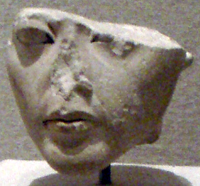Zannanza

Zannanza (died ca. 1324 BC) was a Hittite prince, son of Suppiluliuma I, king of the Hittites. He is best known for almost becoming the Pharaoh of Egypt, and because his death caused a diplomatic incident between the Hittite and Egyptian Empires, that resulted in warfare.
Biography
The Egyptian Queen Dakhamunzu, who could have been Meritaten or Nefertiti, but is most often identified as Ankhesenamun, asked Suppiluliuma I to send over a son during the late eighteenth dynasty of Egypt because she had recently been widowed by the death of Nibhururia (possibly Akhenaten, but more likely Tutankhamun), and had borne no heir. Her letter reads,
"My husband has died and I have no son. They say about you that you have many sons. You might give me one of your sons to become my husband. I would not wish to take one of my subjects as a husband... I am afraid." [1]
The Egyptian royal lineage was traced through its women so marriage to this queen would enable him to become the pharaoh. It was extraordinary that a consort from outside of Egypt would be sought, however, so Suppiluliuma was cautious. After sending an envoy to verify her claim, he obliged her. His son, Zannanza, was chosen and sent to Egypt to become the new pharaoh. This could have led to efforts to make Egypt part of the Hittite empire. Zannanza never made it past the Egyptian border, and exactly what became of him is unknown.
His father accused the Egyptians of murdering him. The new king of Egypt, Ay, denied the murder, but acknowledged the death. Angry letters were passed between the two nations, but the matter ended inconclusively. Hittite forces subsequently attacked Egyptian settlements in Syria.[2]
References
- ^ Suzie Manley. "Ankhesenamun - Queen of Tutankhamun and Daughter of Akhenaten". Egypt * Pyramids * History.
- ^ Museum Tours - Amarna
